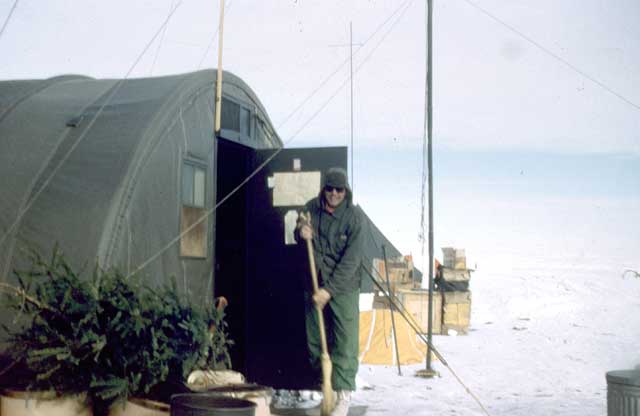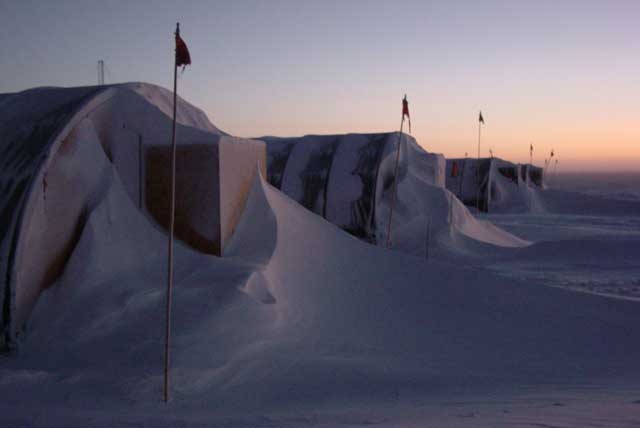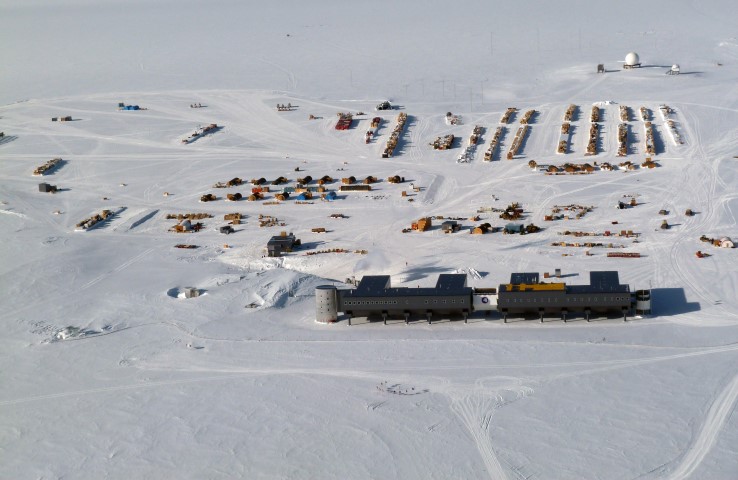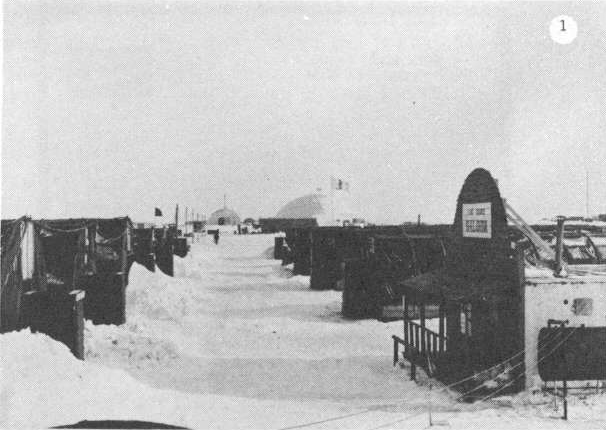Frontier livingHistoric Jamesways have been part of South Pole Station since 1950sPosted July 11, 2014
This isn’t the sort of summer camp where you send the kids – never mind that few people under age 18 ever go to Antarctica, let alone the South Pole. In the modern era, Summer Camp became known as the collection of Jamesways and other buildings at the Amundsen-Scott South Pole Station 
Photo Credit: Dick Prescott/Antarctic Photo Library
A U.S. Navy man sweeps outside of a Jamesway at the South Pole Station in December 1956.
Now Summer Camp is going away. The population has drawn back to about 150 people, the size for which the elevated station was designed to accommodate when it was dedicated in January 2008. Several of the Jamesways were knocked down during the 2013-14 summer. “Tearing down of the Jamesways is the beginning of the end of summer camp at Altie Meadows,” said Bill Coughran, South Pole Station area manager. [See related article — Tunnel vision: Encroaching ice in utility corridor below South Pole Station shaved back.] The James Manufacturing Company of Fort Atkinson, Wisconsin, created a version of the Quonset hut with wooden ribs and an insulated fabric covering that was first used in the Aleutian Islands during World War II. Portable and easy to assemble, the hut was designed for arctic weather conditions when personnel were wearing bulky clothes and mittens but needed to construct a shelter quickly. The insulated blankets were made with glass fiber insulation faced with flame-proof muslin and enclosed in plastic-treated cotton that was water-, vermin- and fire-proof. The hardware was the only metal component. The whole package only weighed 1,200 pounds, and its wooden packing crates were designed for reuse as the hut floor. Jamesways were first used at the South Pole when the station was established during the summer of 1956-57 for the International Geophysical Year (IGY) At Old Pole, as the IGY station was later called, there usually were Jamesways to house the summer crowd. That was particularly true the first summer when the station was being built. Later, when the ski-equipped LC-130s In the 1970s, when the new domed South Pole Station was being built, a camp for the workers was constructed in 1972-73 to house a complement of about 110 members of the Seabee It wasn’t referred to as summer camp then, but instead it took on the air of a frontier town. Dry Gulch “As a diversion from their incredibly difficult workload, I let the men construct a recreation room from shipping crates,” wrote Lt. Cmdr. Bill Kay. “Their typical Seabee cleverness and talent eventually resulted in the Hollywood-type facade for the Last Chance Saloon, complete with hitching post (honest!). “Another well-known trait of Seabees is their absolutely uncanny ability to create things from thin air, and the appearance of that shuffleboard, pool table and foosball game still bewilder me to this day!” 
Photo Credit: Patrick Hovey/Antarctic Photo Library
Snow piles up against the Jamesways at Summer Camp.
The camp was used to house military (and later civilian) construction workers up through the project completion at the end of the 1974-75 season. The camp was not opened in 1975-76, primarily because the construction and science schedules had been severely curtailed by aircraft mishaps that year. In 1976-77, the camp was in the process of being opened when it was hit by two fires on Oct. 30-31, less than 24 hours after the 1976-77 summer crew arrived to start the season. The first was a small electrical fire on Oct. 30 in one of the berthing Jamesways, which rendered it uninhabitable. The second fire on Oct. 31 was a spectacular blaze that destroyed a complex that housed the kitchen and bathroom (in Navy speak, galley and head). The summer crew was in the process of putting the facility into operation to help feed the huge summer crowds – up to 80 people – that they were expecting that season. As a result of the fire, the decision was made to feed the entire summer population from the galley inside the dome – a practice that continued into the early 2000s before the kitchen in the newest station was completed. A new “emergency” head/galley and berthing complex was constructed closer to the dome, and the remaining undamaged Jamesways were dismantled for use elsewhere. The emergency camp consisted of two long Jamesways, one containing the galley, head and dining room, with an oil-fired snowmelter. The other Jamesway was used as berthing, with open-bay bunk beds. 
Photo Credit: Jesse Peterson/Antarctic Photo Library
An aerial view of the new South Pole Station, bottom right, and Summer Camp, middle left, in January 2012.
A power plant was set up in an adjacent building that had been used as a garage during the domed station construction. A power cable interconnected it with the dome power plant so that the camp could be powered from the dome or the dome could be partially powered from the emergency power plant if necessary. The term “summer camp” still did not exist. It was referred to as the construction camp, emergency camp, or “emcamp,” a term adopted by the 1976-77 crew that apparently didn’t stick for long. “Summer camp” was invented at some unknown time between 1977 and 1986. The modern-day summer camp started to take shape in the early 1980s with construction of two berthing Jamesways in 1981-82. The complex also included a head, galley/lounge and power plant. Three more Jamesways were added between 1984-85 and 1988-89. The galley and lounge suffered a fire in January 1990. It was replaced the following season. By 1991-92, summer camp consisted of 10 Jamesways with two heads and the new galley/lounge. The final summer camp/emergency power plant was built in 1996-97 with two 150-kilowatt generators and paralleling switchgear. Photo Credit: Scott Smith
A crane is used to move a Jamesway to the current location of Summer Camp in 1998.
This would remain as the station emergency power plant until the new power plant for the elevated station went online in January 2001. The old dome power plant became the emergency power plant. A backup power plant is now located in one of the berthing wings of the elevated station. At some point, there were no more open-bay floor plans with bunk beds separated by blankets hung from the ceiling in the berthing Jamesways. Permanent fire-resistant partitions and private rooms were added inside, replacing bunk beds with sleeping bags. Forced-air furnaces were built in separate structures to improve fire safety. In 1997-98, summer camp was moved to its current location and arrangement. Each building was relocated with a crane and moved in one piece instead of being dismantled and rebuilt. There is no plan to save unneeded structures for posterity, as what was done with the South Pole domed station, when it was disassembled and shipped to Port Hueneme, Calif., for storage in 2010. The top ring of the dome now sits in the Seabee Museum at Port Hueneme. [See previous article — The Dome is down: Iconic South Pole Station building disassembled and shipped off Antarctica in one season and Crowning achievement: Top of iconic South Pole Dome hoisted into museum dedicated to Navy Seabees.] Some of the Jamesways at summer camp will continue to be used for temporary storage – a 20th century relic in a 21st century research facility at the end of the world. |



For USAP Participants |
For The Public |
For Researchers and EducatorsContact UsU.S. National Science FoundationOffice of Polar Programs Geosciences Directorate 2415 Eisenhower Avenue, Suite W7100 Alexandria, VA 22314 Sign up for the NSF Office of Polar Programs newsletter and events. Feedback Form |



